Lanzarote, Canary Islands - pelagic and island birding at the beginning of summer
John Muddeman
10/07/2012 10:12:19
A photo-blog plus a few notes from a recent long weekend excursion to Lanzarote, where a 2-day pelagic trip was planned to take us out to the Banco de la Concepción to look for seabirds and cetaceans at possibly one of the most accessible marine hot-spots in European waters.
Posted in: Flora, Butterflies and Moths, Reptiles, Birds, Endangered Wildlife and Habitats | Canary Islands | Spanish Islands
Two of Spain's top birders have set up a small company, Lanzarote Pelagics, in order to try and get out to the Banco de la Concepción, a sea mount starting some 48 nm to the N of Lanzarote which rises up from around 2500m to just 180-200 metres below the surface. Here it is believed that cold and nutrient-rich upwelling waters provide rich feeding grounds for all levels of marine life, including large numbers of seabirds and cetaceans.
Indeed, this area has been highlighted for investigation following the results of some at-sea investigations on the distribution of birds around Spain's shores, when a SEO/BirdLife team noted a few Pterodroma petrels here, which at the time constituted virtually the only records for this group in Spanish waters.
These birds are exceptionally difficult to see anywhere, with three forms breeding in the N Atlantic being involved, plus the outside chance that a further S Atlantic breeding species might occur. Since one of these birds is the critically endangered Zino's Petrel P. madeira (68 pairs in 2012), and the other two are the so-called Deserta's Petrel P. (feae) deserta (150-250 pairs estimated) and Fea's Petrel P. (feae) feae (250-500 pairs estimated), interest in finding out more about their at-sea distribution and behaviour and seeing them is obviously high!
The waters off the Canary Islands are rich in N Atlantic breeding seabirds anyway, including large numbers of Cory's Shearwaters Calonectris diomedea diomedea, Manx Shearwaters Puffinus puffinus, the rare and apparently rapidly declining Barolo's Shearwater Puffinus baroli, White-faced Storm-petrel Pelagodroma marina, Madeiran Storm-petrel Oceanodroma castro (of both summer and winter-breeding forms, often now considered different species) and European Storm-petrel Hydrobates pelagicus, while the list of other regularly-occurring pelagic seabirds includes Wilson's Storm-petrel Oceanites oceanicus, even though the latter was only recorded for the Canary Islands for the first time during the May trips! In fact, just about anything marine can turn up, and plenty of cetaceans and even hammerhead sharks and Loggerhead Turtles are present in the area.
The trips are basically by birders for birders, at least at present until a better understanding of what may be seen there is established, but of course, being in open waters of the Atlantic poses a few logistic problems! The first trips were taken out of N Lanzarote last September, with spectacular results, which can be seen in the Lanzarote Pelagics blogspot, but included the first unequivocal South Polar Skuas Skua maccormicki for Iberia and the Western Palearctic's second Black-bellied Storm-petrel Fregetta tropica!
For 2012, the idea of using a larger boat, giving more observation stability and with the possibility of staying out overnight in the main area of interest, was put into place. But naturally, this is open ocean, and the first trip in late May met conditions too rough to stay out overnight, so they returned to port and left again the following morning. The results were promising, including the first Scopoli's Shearwater Calonectris (diomedea) diomedea for the Canary Islands, and can also be seen on the first page of the blogspot.
Sadly, the late June / early July 2012 weekend met even tougher conditions, so after our first day out in 20 knot winds and a 2-2.5m swell (this is tiring after 13h!), and reaching just 32 nm from shore, and in the light of a forecast for the following day of 30 knot winds and a 3m swell, this was cancelled by the skipper. And to be honest, since viewing conditions were so difficult with these conditions and given the impossibility of even reaching the Banco de la Concepción (boat speed on the first day was down to around 6 knots given head-on winds and swell), most of us weren't unduly disappointed! Coincidentally it also allowed us to be in shape for the European Cup Final, and while I don't usually take great interest in these things, I have to say that we had a fabulous evening out celebrating the game at an English 'pub' close to where we were staying...
The results are largely shown visually below, though I hope there will be a new entry on the LB site soon to provide the 'official' figures.
Cory's Shearwater Calonectris diomedea borealis - several hundred
Scopoli's Shearwater Calonectris diomedea diomedea - I believe two, but pending seeing others' photos
Manx Shearwater Puffinus puffinus - 5-6
Bulwer's Petrel Bulweria bulwerii - 10-12 (possibly a few more, as very dispersed)
European Storm-petrel Hydrobates pelagicus - one-three were regularly in sight behind the boat at once, with probably some 20-30 during the whole day
Madeiran Storm-petrel Oceanodroma castro - 3-4
Wilson's Storm-petrel Oceanodroma oceanicus - 3
White-faced Storm-petrel Pelagodroma marina - undoubtedly the star, with up to three present simultaneously and some 25-30 during the day
Atlantic Spotted Dolphin - one excellent pod of 6-8 ind.
Striped Dolphin - seen by others
Atlantic Bottlenose Dolphin - two pods, including one quite large one of perhaps 20 ind.
(Loggerhead) Turtle - at least 2
Hammerhead Shark - at least 2 seen by others
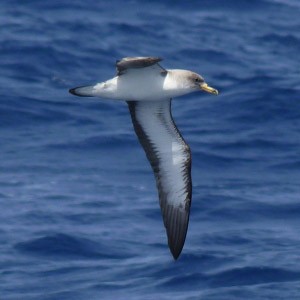 A typical Cory's Shearwater showing the
A typical Cory's Shearwater showing the
extensive dark area on the under primaries
Calonectris (diomedea) borealis© John Muddeman
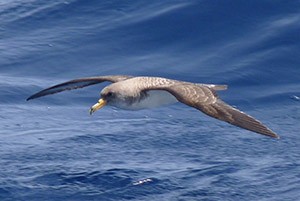 Another Cory's Shearwater from a different angle
Another Cory's Shearwater from a different angle
Calonectris (diomedea) borealis© John Muddeman
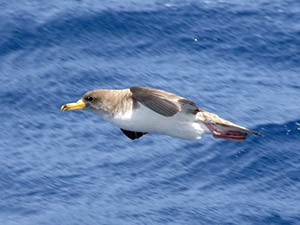 and another Cory's Shearwater showing the feet
and another Cory's Shearwater showing the feet
Calonectris (diomedea) borealis© John Muddeman
 scopoli.jpg) This Scopoli's-type Shearwater shows tongues of
This Scopoli's-type Shearwater shows tongues of
white extending into the bases of the primaries
and just one dark spot on the leading edge of the
wing at the very base of the primaries
Calonectris (diomedea) diomedea© John Muddeman
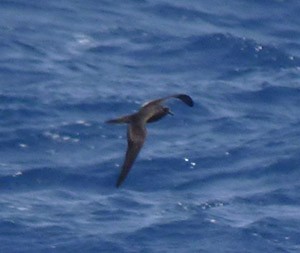 Extremely fast, agile and boat-shy, Bulwer's Petrels
Extremely fast, agile and boat-shy, Bulwer's Petrels
like this one are a challenge to photograph at all!
Bulweria bulwerii© John Muddeman
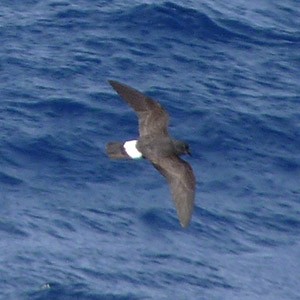 European Storm-petrel is the smallest 'stormie' here
European Storm-petrel is the smallest 'stormie' here
and shows almost plain upperwings
Hydrobates pelagicus© John Muddeman
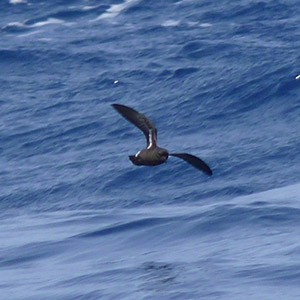 While the diagnostic white underwing stripe on the
While the diagnostic white underwing stripe on the
coverts of European Storm-petrel shows well
at many angles
Hydrobates pelagicus© John Muddeman
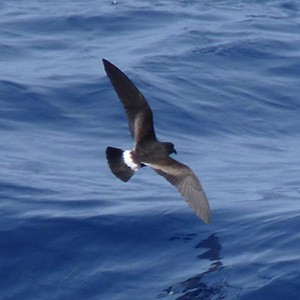 Madeiran Storm-petrel is much larger in direct
Madeiran Storm-petrel is much larger in direct
comparison, with a much more direct and powerful
flight action, as well as a pale ulnar bar of
moderate length and width
Oceanodroma castro© John Muddeman
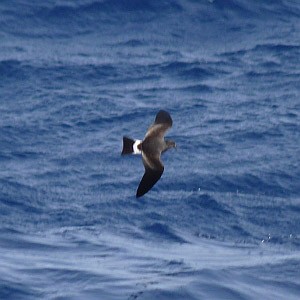 Although slightly blurred, this shows the overall
Although slightly blurred, this shows the overall
shape and pattern of Madeiran Storm-petrel well
Oceanodroma castro© John Muddeman
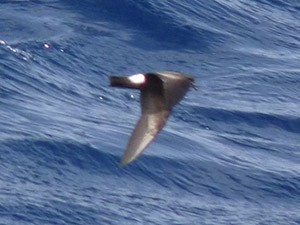 While this photo of the same Madeiran Storm-petrel
While this photo of the same Madeiran Storm-petrel
shows a false underwing bar caused by light
reflection, though its shape and position are
very different from in European Storm-petrel
Oceanodroma castro© John Muddeman
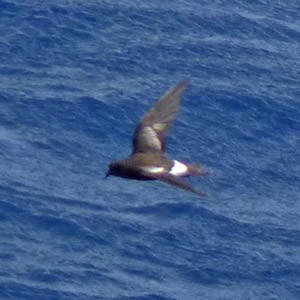 This was the first Wilson's Storm-petrel to appear
This was the first Wilson's Storm-petrel to appear
and was easily identified first by the very broad
ulnar bar, secondly by the active moult and thirdly
by the long legs & toes which project well beyond
the tail in flight
Oceanites oceanicus© John Muddeman
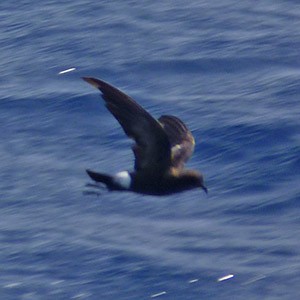 Not much bigger than European Storm-petrel,
Not much bigger than European Storm-petrel,
Wilson's has comparatively much broader wings at
the wing bend, a big ulnar bar and no true white
underwing stripe (though beware false photographic
effects), to help separate it at sea.
Oceanites oceanicus© John Muddeman
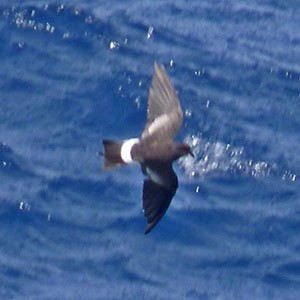 Despite the moult affecting the shape, this angle
Despite the moult affecting the shape, this angle
illustrates well the relatively broad wings
of Wilson's Storm-petrel
Oceanites oceanicus© John Muddeman
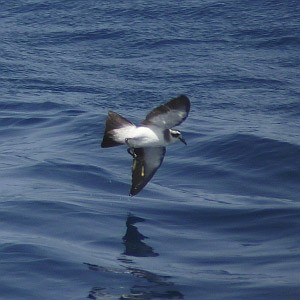 Phwoar! White-faced Storm-petrel is one of the most
Phwoar! White-faced Storm-petrel is one of the most
exquisite seabirds I've seen. This was probably
the best shot I could muster with my simple
camera but the yellow webbing on the feet can
even be seen.
Pelagodroma marina© John Muddeman
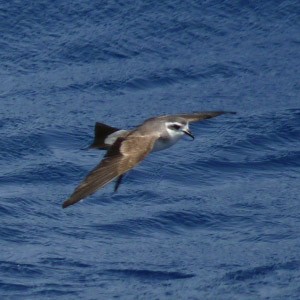 The White-faced Storm-petrels were the biggest
The White-faced Storm-petrels were the biggest
and least shy of the stormies present, and their
extraordinary habit of springing forward off the
surface of the sea on their amazingly long legs
has to be seen to be believed.
Pelagodroma marina© John Muddeman
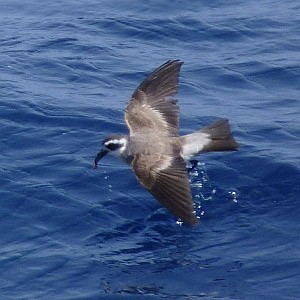 White-faced Storm-petrel
White-faced Storm-petrel
Pelagodroma marina© John Muddeman
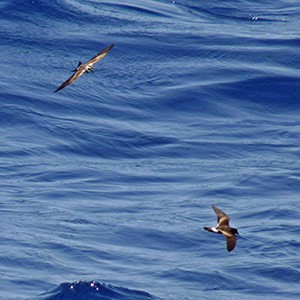 An interesting comparison shot of Madeiran & White-
An interesting comparison shot of Madeiran & White-
faced Storm-petrels
Pelagodroma marina & Oceanodroma castro© John Muddeman
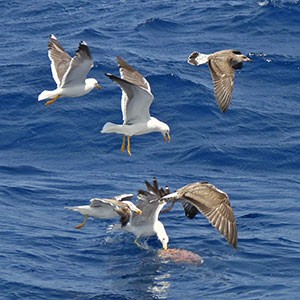 Obviously, birds don't just come around for no reason,
Obviously, birds don't just come around for no reason,
and frozen blocks of chum are used to bring birds in,
and the sea also marked using fish oil which is simply
poured overboard. Here atlantis Yellow-legged
Gulls were hovering over the chum block and indeed
were constantly present at each of the four or five
blocks thrown overboard during the trip© John Muddeman
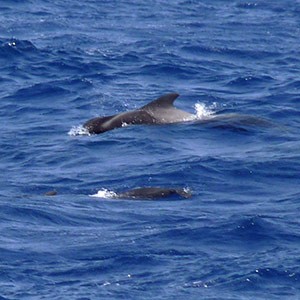 Short-finned Pilot Whales
Short-finned Pilot Whales
Globicephala macrorhyncha© John Muddeman
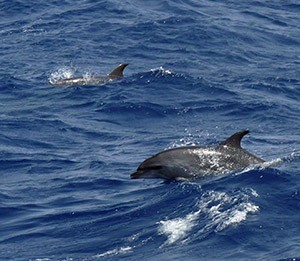 Atlantic Bottlenose Dolphin
Atlantic Bottlenose Dolphin
Tursiops truncatus© John Muddeman
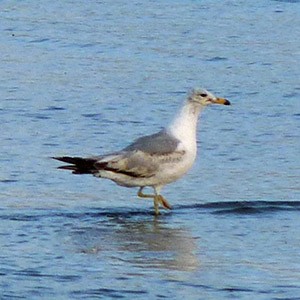 Ok, so it's a poor shot of a second-summer Ring-
Ok, so it's a poor shot of a second-summer Ring-
billed Gull, but it was a new bird for my
Spanish list!
Larus delawarensis© John Muddeman
Read more blog posts